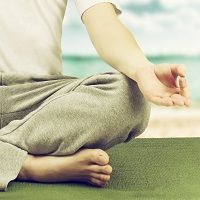Article
COPD: Yoga Just as Effective as Standard Pulmonary Rehabilitation
Author(s):
Imagine if there was a wallet-friendly rehabilitation strategy for patients with chronic obstructive pulmonary disease (COPD) that provides the same benefits as standard care. Well, you can stop imagining and see it for yourself.

Imagine if there was a wallet-friendly rehabilitation strategy for patients with chronic obstructive pulmonary disease (COPD) that provides the same benefits as standard care. Well, you can stop imagining and see it for yourself.
According to Randeep Guleria, MD, DM, from the Pulmonary Medicine and Sleep Disorders department at the All India Institute of Medical Sciences, yoga is just as effective as standard pulmonary rehabilitation. The findings will be presented in a poster session at CHEST 2015 in Montréal, Canada.
Guleria and colleagues evaluated 60 patients with COPD for 12 weeks. Half of the patients were randomly assigned into group one which consisted of yoga exercises, including asanas, pranayama, mediation, and relaxation techniques. Group two received standard pulmonary rehabilitation. During the first four weeks, all participants went through one hour of training two times per week. The training continued during the last eight weeks of the study, but was only supervised once every two weeks and practiced at home otherwise.
Lung functions, quality of life, serum inflammatory markers (CRP and I1-6), and dyspnea assessment (six-minute walk test, Borg scale, and VAS) were reported at baseline and at the end of the 12 weeks in both groups.
Group one (yoga exercises) averages:
- Baseline CRP: 1.0 mg/dl --> After 12 Weeks: 0.70 mg/dl
- Baseline I1-6: 23.10 pg/ml --> After 12 Weeks: 32.74 pg/ml
- Baseline 6MWT: 419.0±128.12 meters --> After 12 Weeks: 456.43±91.41 meters
- Baseline Borg Scale: 1.50 --> After 12 Weeks: 1.0
- Baseline VAS: 55.17±8.55 mm --> After 12 Weeks: 70.36±8.81 mm
Group two (standard pulmonary rehabilitation) averages:
- Baseline CRP: 1.15 mg/dl --> After 12 Weeks: 0.80 mg/dl
- Baseline I1-6: 6.65 pg/ml --> After 12 Weeks: 36.28 pg/ml
- Baseline 6MWT: 391.88±113.10 meters --> After 12 Weeks: 424.66±78.21 meters
- Baseline Borg Scale: 3.00 --> After 12 Weeks: 0.50
- Baseline VAS: 49.67±17.61 mm --> After 12 Weeks: 67.24±17.55 mm
Furthermore, group one showed significant improvement in quality of life, however, group two did not.
“Yoga and PMR exercises done in a structured manner result in similar improvement in pulmonary functions, six-minute walk distance, Borg scale, severity of dyspnea, quality of life, and levels of C-reactive protein after 12 weeks of training,” the authors summarized.
The team concluded that yoga is just as effective, as well as cost-effective, as standard PMR exercises.





